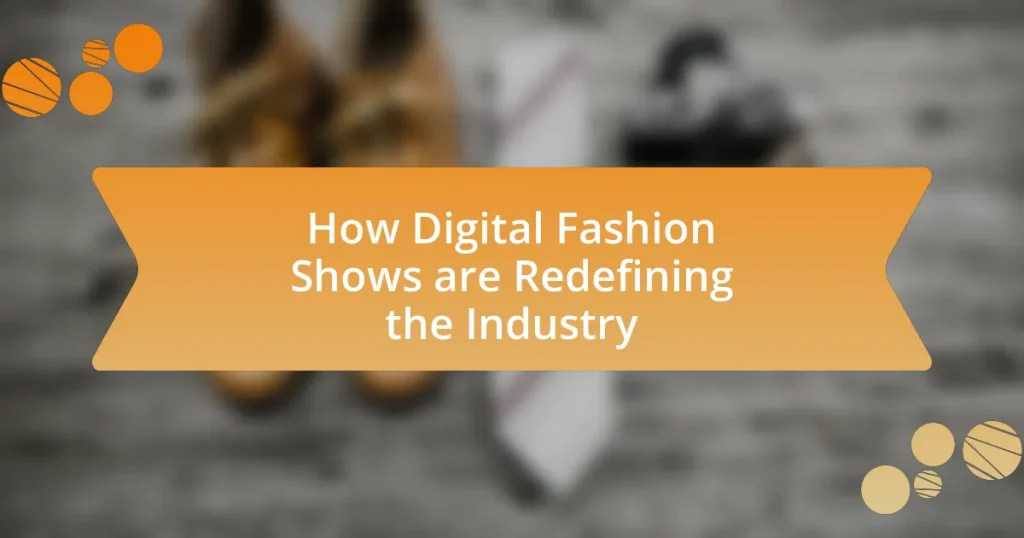Digital fashion shows are virtual presentations that utilize technology to showcase fashion collections, allowing brands to reach a global audience without the constraints of physical venues. This article explores how digital fashion shows differ from traditional formats, the technologies involved, and the impact of the COVID-19 pandemic on their rise. It also examines audience engagement strategies, the challenges brands face in transitioning to digital formats, and the opportunities these shows create for emerging designers. Additionally, the article discusses future trends, including the integration of augmented and virtual reality, sustainability practices, and best practices for successful digital fashion show experiences.

What are Digital Fashion Shows?
Digital fashion shows are virtual presentations of fashion collections that utilize digital technology to showcase designs, often through live-streaming or pre-recorded videos. These shows allow brands to reach a global audience without the limitations of physical venues, enabling wider accessibility and engagement. The rise of digital fashion shows has been accelerated by the COVID-19 pandemic, which prompted many designers to adapt to online formats, exemplified by events like the digital Paris Fashion Week in 2020. This shift not only enhances the visibility of fashion brands but also allows for innovative storytelling and interactive experiences, fundamentally transforming how fashion is presented and consumed.
How do Digital Fashion Shows differ from traditional fashion shows?
Digital fashion shows differ from traditional fashion shows primarily in their format and accessibility. Traditional fashion shows are physical events held in specific locations, often limited to invited guests, while digital fashion shows utilize online platforms to reach a global audience, allowing anyone with internet access to view the presentations. This shift enhances inclusivity and democratizes fashion, as evidenced by the rise of virtual platforms like Balenciaga’s 2021 digital show, which attracted millions of viewers worldwide, compared to the limited seating of conventional shows.
What technologies are utilized in Digital Fashion Shows?
Digital fashion shows utilize technologies such as augmented reality (AR), virtual reality (VR), 3D modeling, and live streaming. These technologies enable designers to create immersive experiences that showcase their collections in innovative ways. For instance, AR allows viewers to see garments in a real-world context through their devices, while VR can transport audiences to virtual environments where they can interact with the fashion pieces. Additionally, 3D modeling facilitates the creation of detailed digital garments, which can be rendered and displayed in real-time during live streaming events. This integration of advanced technologies not only enhances viewer engagement but also expands the reach of fashion shows beyond traditional physical venues.
How do audience engagement strategies vary between formats?
Audience engagement strategies vary significantly between digital and traditional formats. In traditional fashion shows, engagement often relies on in-person attendance, exclusive access, and direct interaction with models and designers, fostering a sense of community and exclusivity. Conversely, digital formats utilize interactive elements such as live streaming, social media integration, and virtual reality experiences, allowing broader audience participation and real-time feedback. For instance, a study by McKinsey & Company highlights that digital fashion shows can reach up to 10 times more viewers than physical events, demonstrating the effectiveness of digital engagement strategies in expanding audience reach and interaction.
Why are Digital Fashion Shows gaining popularity?
Digital fashion shows are gaining popularity due to their ability to reach a global audience and provide immersive experiences. Traditional fashion shows are often limited by physical location and attendance, whereas digital formats can be accessed by anyone with an internet connection, significantly expanding viewership. For instance, during the COVID-19 pandemic, brands like Balenciaga and Gucci successfully transitioned to digital platforms, attracting millions of viewers online, which highlighted the potential for broader engagement. Additionally, digital fashion shows allow for innovative storytelling and creative presentations that can incorporate augmented reality and interactive elements, enhancing viewer engagement and experience.
What role does accessibility play in the rise of Digital Fashion Shows?
Accessibility significantly enhances the rise of Digital Fashion Shows by allowing a broader audience to engage with fashion events that were previously limited to physical attendance. Digital platforms eliminate geographical barriers, enabling viewers from diverse locations to participate in real-time or on-demand, thus expanding the reach of fashion brands. For instance, during the COVID-19 pandemic, many fashion houses transitioned to digital formats, resulting in increased viewership; for example, the Balenciaga Fall 2021 show attracted over 5 million online viewers, showcasing the potential of digital accessibility. This shift not only democratizes access to fashion but also fosters inclusivity, allowing individuals who may have physical or financial constraints to experience high-fashion events.
How has the COVID-19 pandemic influenced the shift to digital formats?
The COVID-19 pandemic has significantly accelerated the shift to digital formats across various industries, including fashion. As physical events were restricted due to health guidelines, brands and designers turned to virtual platforms to showcase their collections, leading to an increase in digital fashion shows. According to a report by McKinsey & Company, 75% of fashion executives noted that the pandemic prompted them to adopt digital solutions more rapidly than planned. This shift not only allowed for broader audience reach but also facilitated innovative presentations, such as 3D modeling and augmented reality experiences, which enhanced consumer engagement.

What impact do Digital Fashion Shows have on the fashion industry?
Digital fashion shows significantly transform the fashion industry by enhancing accessibility and broadening audience reach. These virtual events allow brands to showcase their collections to a global audience without geographical limitations, increasing visibility and engagement. For instance, during the COVID-19 pandemic, brands like Balenciaga and Gucci successfully utilized digital platforms to present their collections, resulting in millions of views and interactions online. This shift not only democratizes fashion but also reduces costs associated with traditional runway shows, such as venue rentals and physical logistics. Consequently, digital fashion shows are reshaping marketing strategies and consumer interactions within the industry.
How are brands adapting their marketing strategies for Digital Fashion Shows?
Brands are adapting their marketing strategies for Digital Fashion Shows by leveraging technology to enhance audience engagement and reach. This includes utilizing live streaming platforms, social media integration, and interactive features that allow viewers to shop directly from the show. For instance, brands like Balenciaga and Gucci have successfully incorporated augmented reality (AR) and virtual reality (VR) elements into their presentations, creating immersive experiences that attract a global audience. Additionally, data analytics is being employed to tailor content and marketing efforts based on viewer preferences, ensuring a more personalized experience. This shift is evidenced by the increase in online viewership, with reports indicating that digital fashion shows can attract millions of viewers, significantly expanding brand visibility compared to traditional runway shows.
What new opportunities do Digital Fashion Shows create for emerging designers?
Digital Fashion Shows create new opportunities for emerging designers by providing a global platform to showcase their collections without the constraints of traditional runway shows. These virtual events allow designers to reach a wider audience, including potential buyers, media, and consumers, regardless of geographical limitations. For instance, during the COVID-19 pandemic, many designers utilized digital platforms to present their work, resulting in increased visibility and engagement. Additionally, digital shows often require lower production costs compared to physical events, enabling emerging designers to allocate resources towards creativity and innovation rather than logistics. This shift not only democratizes access to the fashion industry but also fosters a more inclusive environment for diverse voices and styles.
How do Digital Fashion Shows affect consumer behavior and purchasing decisions?
Digital fashion shows significantly influence consumer behavior and purchasing decisions by enhancing accessibility and engagement. These virtual events allow consumers to view collections in real-time from anywhere, increasing exposure to brands and products. A study by McKinsey & Company found that 65% of consumers are more likely to purchase items they see in digital formats compared to traditional shows. Additionally, digital fashion shows often incorporate interactive elements, such as live shopping features, which can lead to immediate purchasing actions. This shift towards digital platforms has been shown to create a sense of urgency and exclusivity, further driving consumer interest and sales.
What challenges do brands face when transitioning to Digital Fashion Shows?
Brands face several challenges when transitioning to digital fashion shows, primarily including technological limitations, audience engagement, and brand identity preservation. Technological limitations can hinder the quality of the digital experience, as brands must invest in high-quality streaming and virtual environments to replicate the immersive experience of physical shows. Audience engagement poses a challenge because brands need to create interactive and captivating content that resonates with viewers online, which differs from the traditional runway experience. Additionally, preserving brand identity becomes complex in a digital format, as brands must adapt their storytelling and visual aesthetics to fit a virtual platform while maintaining their unique essence. These challenges require strategic planning and investment to ensure successful digital transitions.
How can brands overcome technical difficulties during live streaming?
Brands can overcome technical difficulties during live streaming by investing in robust technology and conducting thorough pre-event testing. Implementing high-quality streaming equipment, reliable internet connections, and backup systems ensures a seamless experience. According to a study by Livestream, 80% of viewers prefer live video over other formats, highlighting the importance of reliability in live streaming. Additionally, brands should have a dedicated technical support team available during the event to address any issues promptly, which can significantly reduce downtime and enhance viewer engagement.
What are the potential pitfalls of relying solely on digital formats?
Relying solely on digital formats can lead to several significant pitfalls, including the loss of tactile experience and potential accessibility issues. The tactile experience of physical garments allows consumers to assess fabric quality and fit, which is crucial in fashion. A study by the Fashion Institute of Technology found that 70% of consumers prefer to touch and try on clothing before purchasing, highlighting the importance of physical interaction. Additionally, digital formats may exclude individuals with limited access to technology or internet connectivity, creating disparities in consumer engagement. According to the Pew Research Center, approximately 15% of Americans do not use the internet, which can limit the reach of digital-only fashion initiatives.

What are the future trends in Digital Fashion Shows?
Future trends in digital fashion shows include increased use of augmented reality (AR) and virtual reality (VR) technologies, which enhance viewer engagement by allowing immersive experiences. Brands are leveraging these technologies to create interactive environments where audiences can explore collections in 3D. Additionally, the integration of artificial intelligence (AI) for personalized experiences is on the rise, enabling tailored recommendations based on user preferences. According to a report by McKinsey & Company, the digital fashion market is projected to grow significantly, indicating a shift towards more sustainable and accessible fashion presentations. Furthermore, live-streaming capabilities are evolving, allowing real-time interaction between designers and audiences, which fosters a sense of community and immediacy. These trends reflect a broader movement towards innovation and inclusivity in the fashion industry.
How might technology evolve in the realm of Digital Fashion Shows?
Technology in digital fashion shows is likely to evolve through advancements in virtual reality (VR), augmented reality (AR), and artificial intelligence (AI). These technologies will enhance viewer engagement by creating immersive experiences that allow audiences to interact with fashion in real-time. For instance, VR can enable users to attend shows from anywhere in the world, while AR can allow them to visualize clothing on themselves through their devices. Additionally, AI can analyze viewer preferences and trends, tailoring content to individual tastes, which has been shown to increase consumer engagement and sales in the fashion industry. As a result, the integration of these technologies will redefine how fashion is presented and consumed, making it more accessible and personalized.
What role will virtual reality and augmented reality play in future shows?
Virtual reality (VR) and augmented reality (AR) will play a transformative role in future shows by enhancing audience engagement and creating immersive experiences. These technologies allow designers to present their collections in innovative ways, enabling viewers to interact with garments and environments in real-time. For instance, brands like Balenciaga and Gucci have already utilized VR and AR to showcase their collections, allowing users to experience fashion shows from their own homes, thus expanding reach and accessibility. According to a report by McKinsey & Company, the integration of VR and AR in fashion can increase consumer engagement by up to 70%, demonstrating their potential to redefine how fashion is experienced and consumed.
How can sustainability be integrated into Digital Fashion Shows?
Sustainability can be integrated into Digital Fashion Shows by utilizing virtual platforms that minimize resource consumption and carbon emissions associated with traditional fashion events. Digital shows eliminate the need for physical venues, travel, and extensive materials, thus significantly reducing waste. For instance, brands like Balenciaga and Gucci have adopted digital formats to showcase collections, which not only lowers their environmental footprint but also allows for innovative storytelling and engagement with audiences. According to a report by McKinsey & Company, the fashion industry could reduce its carbon emissions by 30% through digital transformation, highlighting the potential impact of integrating sustainability into digital formats.
What best practices should brands follow for successful Digital Fashion Shows?
Brands should prioritize high-quality production and engaging storytelling for successful Digital Fashion Shows. High-quality visuals and sound enhance viewer experience, making the show more appealing and professional. Engaging storytelling captivates the audience, allowing them to connect emotionally with the brand and its collection. Additionally, leveraging social media platforms for promotion and interaction increases reach and engagement, as evidenced by the success of brands like Balenciaga and Gucci, which effectively utilized platforms like Instagram and TikTok to engage audiences during their digital shows. Furthermore, incorporating interactive elements, such as live chats or polls, fosters real-time engagement and feedback, enhancing viewer involvement and satisfaction.
How can brands effectively promote their Digital Fashion Shows to maximize reach?
Brands can effectively promote their Digital Fashion Shows to maximize reach by leveraging social media platforms, influencer partnerships, and targeted advertising. Social media channels like Instagram, TikTok, and Facebook allow brands to engage with a broad audience through live streaming, behind-the-scenes content, and interactive features. Influencer partnerships can amplify visibility, as influencers with large followings can share the event with their audiences, driving traffic and interest. Additionally, targeted advertising on platforms such as Google and Facebook can reach specific demographics, ensuring that promotional efforts are directed toward potential customers. According to a report by Statista, 54% of consumers use social media to discover new brands, highlighting the effectiveness of these promotional strategies.
What are the key elements of a successful Digital Fashion Show experience?
The key elements of a successful Digital Fashion Show experience include high-quality production, engaging storytelling, interactive features, and effective marketing strategies. High-quality production ensures that visuals and audio are clear and professional, which enhances viewer engagement. Engaging storytelling captivates the audience by creating a narrative around the collection, making it more memorable. Interactive features, such as live chats or polls, allow viewers to participate actively, fostering a sense of community. Effective marketing strategies, including targeted social media campaigns and collaborations with influencers, help to reach a wider audience and generate buzz around the event. These elements collectively contribute to a compelling and impactful digital fashion show experience.



